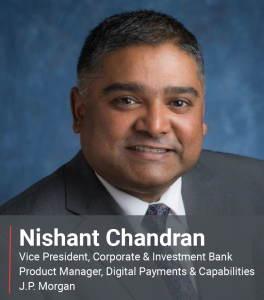How J.P. Morgan’s global experience is helping to shape the future of payments in Canada
To learn about how J.P. Morgan is supporting Canada’s payments Modernization journey, Payments Canada caught up with Nishant Chandran, Vice President, Corporate & Investment Bank and Product Manager, Digital Payments & Capabilities to learn about his role and perspectives on the initiative.
How are you involved in Canada’s payments Modernization efforts?
I’ve been a part of Payments Canada’s Modernization journey since 2012 and am thrilled to be able to participate. The Canadian banking system is considered one of the most robust and mature in the world, and this initiative is critical to ensuring that the Canadian economy can evolve to meet the challenges of changing times and markets. I was involved in the early work done in support of enhancing Automated Funds Transfer (AFT) and supported on the ISO 20022 message development for AFT. In 2018, I worked on transitioning J.P. Morgan’s low-value systems to the third daily exchange period and two-hour funds availability for AFT.
My role at J.P. Morgan is focused on product development and innovation, so the work I do on Modernization plays well into the innovations we’re working on. This is an exciting time to be in payments and I cherish the opportunity to participate in the creation of Canada’s next set of payments systems. Ensuring that these systems and the rules around them are built in a manner that considers security, minimizes risk, friction and fraud while allowing for innovation is essential to enable the Canadian economy to evolve.
You are playing a significant role in support of introducing Canada’s new Real-Time Rail (RTR), can you share more about this role?
The RTR is the first significant new payment rail to be added to the Canadian payments landscape in decades and, in my opinion, of significant importance to the evolution of the Canadian economy.
As our economy adjusts to the challenges of new business models driven by online commerce, food delivery, ride-sharing and subscription-based models to mention just a few of many use cases, the need for an instant, secure, final and ubiquitous payment network becomes critical. The changes forced on Canadians by the pandemic in 2020 have just underscored the need for such a payment rail to better enable frictionless commerce and meet the needs of the new economy.
Given the above, I view my role in the Modernization program as an opportunity to be a part of a team that delivers the systems required to sustain and reinforce our economy. I currently co-chair the RTR Working Group, and I’m a member of the RTR Management Committee and the Fraud Steering Committee, which are all operational committees that are supporting the program. I see my role in these forums as one that provides critical thinking to the group, stimulating active and respectful discussion among its members while bringing them together to ensure that all opinions are considered and represented.
How is J.P. Morgan’s experience in support of other countries’ payments modernization efforts benefiting Canada?
The last decade has seen significant changes to payments infrastructure in jurisdictions around the globe. Several countries have implemented changes to their payments infrastructure, including the modernization of existing systems, the introduction of new real-time/near real-time systems and the use of new payment message formats like ISO 20022.
In the real-time payments space, J.P. Morgan already offers services in the U.S., U.K., Hong Kong, Malaysia, Singapore and Australia. In Europe, the Middle East and Africa, J.P. Morgan is the leading global bank for real-time payments and the only U.S. bank with direct membership of the Single Euro Payments Area Instant Credit Transfers (SEPA Inst) clearing.
In my opinion, as a bank with a significant international presence, J.P. Morgan is uniquely placed to not just provide context on how those payments systems work but also provide a perspective on what worked well and what could be done differently. Our ability to tap into a wealth of professionals in each of those geographies allows us to contribute to the discussion and provide context behind some of the practices in these markets.




